TECHNOLOGY
Dual and intelligent completions optimize Algerian producing gas wells
At Hassi R’Mel field, dual completions could significantly improve output from multi-zone gas wells, but results from intelligent completions look even better.
Mohamed Boussa, Petroleum Engineering and Development, Sonatrach Upstream, and H. Hebbal, Hassi R’Mel and Direction Production, Sonatrach Upstream
Dual completions were used for a long time to produce wells perforated in several zones, mostly for oil wells and rarely for gas wells. To improve production in the upper zones of Algerian gas wells, a study was conducted on producing gas wells with two and three zones in Hassi-R’Mel field. Discovered in 1956, this field is 500 km south of Algiers in the Sahara Desert and is one of the world’s largest wet gas reservoirs.
Engineers at the operator, Sonatrach, studied the choice of completion method and suggested installing dual completions for wells with several zones. This study would demonstrate the necessity of using dual completions in gas producers with several reservoirs, to improve upper-zone production and avoid cross-flow from one zone to another. Initial results made it possible to conduct a technical/economic study that showed the effects on the reservoir, well equipment and investment costs.
This article discusses the advantages and disadvantages of dual completions on gas wells, and shows the profit ratio on capital costs after these completions.
BACKGROUND
Producing gas wells with distinct reservoir horizons like those in Hassi R’ Mel field present distinct production problems. These problems include water influx, cross-flow and low flow from the higher zone (A in this case).
The study was undertaken to determine the proper way to improve these wells’ potential, including the use of dual completions. Several papers were written about using new intelligent completion techniques1,2,3,4 or dual completions to improve gas wells that produce from several zones.5,6,7 This study’s goal was to understand these wells’ problems in detail and outline the potential and necessity of using one of these methods to improve performance.
For this study, engineers selected all Hassi R’Mel producers, whose output from zone A was lower than 200,000 m3/d over a five-year period (2000-2005). The first producing well was drilled in 1956, and it cut a series of sandstones at 2,200 m, confirming the existence of a significant gas accumulation with good petrophysical characteristics and a great extent. This well also highlights the presence of three Triassic sands (designated A - B - C) of Keuper age, separated by a thick shale layer:
- Layer A - the youngest, upper zone, composed of very fine-to-fine-grained sandstones that are locally argillaceous and contain argillaceous conglomerates, with very strong anhydritic cementing in some places.
- Layer B - fine-grained sandstones with intercalated shaly beds distributed along north–south channels.
- Layer C - fine-to-medium-grained sandstones, poorly cemented and with quartizitic conglomerates.
Zones B and C have very good reservoir quality, with gas permeabilities ranging from 300 to 1,200 md. Zone A also has very good gas reservoir quality, but it has lower permeability, generally less than 300 md. A production logging tool (PLT) run on the wells showed that lower zones, B and C, contribute the majority of gas production, compared to zone A that produces a smaller share, in spite of acid stimulation.
In certain cases, the good potential of the lower zones obstructs zone A. Several wells, whose lower zones were isolated, have shown increased flow in zone A. On certain wells cross-flow was observed from a lower zone to the upper zone. On others, water influx appeared in the lower zone.
STUDY
During the study, a simulation was carried out on the various wells, to see which of the two methods, dual or intelligent well completion, would yield the best results. Accordingly, three wells were chosen from gas producers with problems.
Well 1 (water influx). This gas well produces from two zones, A and C. After several years of production, it developed water influx from the bottom lower zone (C). This zone is now isolated by a bridge plug, and the well produces from the upper zone (A), Fig. 1. A PLT run on this well showed that it has limited water influx only.
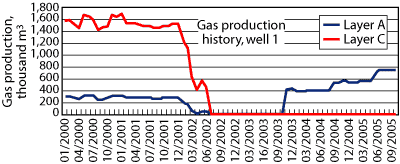 |
Fig. 1. Well 1’s output was from zone C only, after a bridge plug isolated the upper zone, A.
|
|
Well 2 (cross-flow). Gas output is from zones A and C. After one year of production, this well developed water influx from the bottom lower zone (C). When this well was choked, to reduce water influx, a cross-flow appeared, from zone C to zone A, Fig. 2. A PLT was also run on this well, Fig. 4.
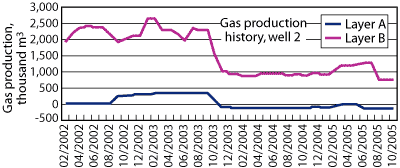 |
Fig. 2. After Well 2 was choked, a cross-flow developed from zone C to zone A..
|
|
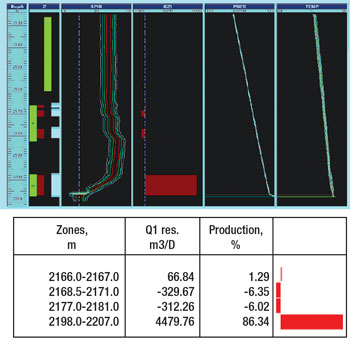 |
Fig. 4. Results from PLT run on Well 2.
|
|
Well 3 (low flow from upper zone). This well produces gas from three zones - A, B and C. It has low flow from the higher zone, Fig. 3.
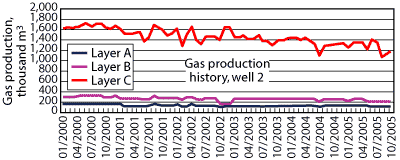 |
Fig. 3. Lowest flow in Well 3 is from the higher zone, A.
|
|
SOLUTION 1
A simulation was undertaken, using the dual completion method.
Well 1 (water influx). The result of correlation with PLT findings shows that one can use the Hagedorne and Brown correlation for simulation in this case. For zone A, engineers used the same head pressure under which the well has been producing, 92 kg/cm2. They also employed 2 7/8-in. tubing. For zone C, the well was choked, with a head pressure of 100 kg/cm2 to ensure flow without water influx, as shown by the PLT. In this zone, 4½-in. tubing was used.
This well had been producing 745,000 m3/d from zone A, while the lower zone, C, was isolated due to water influx. By using a dual completion, it was possible to produce zone C at a rate of 751,702 m3/d, through 4½-in. tubing. Concurrently, zone A would be produced at a rate of 277,240 m3/d through 2 7/8-in. tubing. By employing a dual completion, total production at the surface would be 1,028,942 m3/d, equal to a gain of 284,942 m3/d, or 38%.
Well 2 (cross-flow). For this well, the Hagedorne and Brown correlation was used, following the results of matching with the running of a PLT on the well. In zone A, head pressure was 110 kg/cm2. Tubing size was 2 7/8 in. In zone C, the well was choked, with a head pressure of 112 kg/cm2 to ensure having the same flow without water influx. The tubing was 4½ in.
The well had been producing 620,352 m3/d from zone C, minus 135,000 m3/d that went into zone A, due to the cross-flow. It was determined that by using a dual completion, the lower zone, C, could be produced at a flowrate of 757,760 m3/d through 4½-in. tubing. Zone A would also be producible at a flowrate of 175,623 m3/d through 2 7/8-in. tubing. Accordingly, total production at surface would equal 933,383 m3/d, a gain of 313,031 m3/d, or 50.5%, attributable to the dual completion.
Well 3 (low flow from upper zone). For this well, engineers again used the Hagedorne and Brown correlation, following the results of matching with the PLT run on the well. For zones A and B, 2 7/8-in. tubing was employed, with a head pressure of 100 kg/cm2. In zone C, 4½-in. tubing was used with a head pressure of 100 kg/cm2.
The well had been producing 1,526,500 m3/d, of which 114,500 m3/d came from zone A; 218,000 m3/d were produced from zone B; and 1,194,000 m3/d flowed from zone C.
By using a dual completion, the lower zone, C, could be produced at a flowrate of 1,021,857 m3/d through 4½-in. tubing. Zones A and B would then produce at 327,924 m3/d through 2 7/8-in. tubing. Total production at surface would equal 1,349,782 m3/d.
This production result is less than what the well would produce without a dual completion. Thus, for this category of wells, dual completions are not the ultimate solution, except, perhaps, when using large-diameter tubing.
SOLUTION 2
In light of the simulation results attained with completions, particularly for Well 3, an additional simulation was carried out, using intelligent well completions. Simulation results (sample in Table 1) show that intelligent completions give the best results. They also have advantages compared to dual completions. Furthermore, engineers do not have to change the physical completions. They can control the flow at the bottom via valves, controlled from the surface.
| TABLE 1. Simulation results, intelligent vs. dual completions |
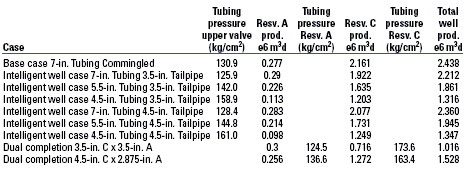 |
|
Nevertheless, with use of dual completions, it is possible to achieve a significant increase in the production of these gas wells. Examples include Well 1, with a gain of 284,942 m3/d and output from zone C (originally isolated because of water influx), and Well 2, with a gain of 313,031 m3/d (which also avoided a cross-flow).
CONCLUSIONS
Producing gas wells with distinct reservoir horizons at Hassi-R’Mel field present production problems. The use of dual or intelligent well completions makes it possible to solve these problems and to improve production. Intelligent well completions give the best results and offer more advantages than dual completions, although the latter can provide significant improvement in flowrates. The intelligent technique allows engineers the luxury of not having to change the physical completion, and they can control the flow at the bottom from the surface. 
ACKNOWLEDGMENTS
The authors wish to thank the management of Petroleum Engineering & Development, SH/AMT, for permission to present and publish this article.
This article is derived from a paper presented at the Petroleum Society’s 7th Canadian International Petroleum Conference (57th Annual Technical Meeting), Calgary, Alberta, Canada, June 13–15, 2006.
LITERATURE CITED
1 G. Mulder, A. Kleinpenning, A. Turco, A. Wagenvoort, B.V. M. Toubar, T. Abd El Rahim Ali, M. Bydoon, H. El Sherbeng Katamsh and P. Thomson, “Evaluation of smart well technology for the Rosetta Phase II development,” OMC 2003, March 26–28, Ravenna, Italy.
2 Sigurd M. Erlandsen, “Production experience from smart wells in the Oseberg field,” SPE paper 62953, Oct. 1–4, 2000, Dallas.
3 S. Rester, J. Thomas, M. Peijs-van Hilten, and W. Vidrine, “Application of intelligent completion technology to optimize the reservoir management of a deepwater Gulf of Mexico field—A reservoir simulation case study,” SPE paper 56670, presented at the SPE Annual Technical Conference and Exhibition, Oct. 3–6, Houston.
4 S. M. Al-Khodhori,” Smart well technologies implementation in PDO for production & reservoir management & control,” SPE paper 81486, presented at the Middle East Oil Show, June 9-12, Kingdom of Bahrain.
5 S. Al-Shaheen, F. Al-Mutairi and A. Zaki,“An innovative approach for logging short string side of dual completion wells: A case study from Kuwait,” SPE paper 81478, presented at the Middle East Oil Show, June 9–12, Bahrain.
6 E. G. Tarr, “ Prospects for dually completed wells in the northern Appalachian basin,” SPE paper 9528, presented at the SPE Eastern Regional Meeting, Nov. 5–7, Morgantown, WVa.
7 S. Al-Shaheen, F. Al-Mutairi, T. P. R. Chandran and A. Zaki, “An innovative approach for logging short string side of dual completion wells: A case study from Kuwait,” SPE paper 81478, Middle East Oil Show, June 9–12, Bahrain.
|
THE AUTHORS
|
|
Mohamed Boussa works at the Center for Technical Studies and Research in the Hassi-R’Mel Department of Petroleum Engineering Development of Sonatrach. He graduated from Institut Algerian du Petrole (IAP) in 1976. Since 1977, he has worked at Sonatrach, although he did return to IAP to complete a reservoir engineering degree, which he received in 1996. Since 2000, Mr. Boussa has been in charge of Hassi R’mel’s data management. In the last few years, he has also written and presented several technical papers on a variety of oil and gas production issues.
|
|
| |
H. Hebbal works in the Hassi-R’Mel Production Directorate. He graduated from National Institute of Hydrocarbons & Chemistry (INHC) in 1997.
|
|








